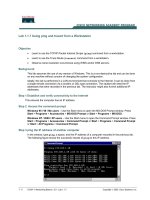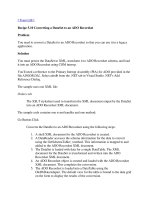Tài liệu Refreshing a DataSet Automatically Using Extended Properties pptx
Bạn đang xem bản rút gọn của tài liệu. Xem và tải ngay bản đầy đủ của tài liệu tại đây (25.96 KB, 4 trang )
[ Team LiB ]
Recipe 9.14 Refreshing a DataSet Automatically Using Extended Properties
Problem
You need to automatically refresh a DataSet periodically.
Solution
Use extended properties and a timer.
The sample code contains two event handlers and one method:
Form.Load
Sets up the sample by creating a DataTable containing the Categories table from
the Northwind database. The default view of the table is bound to a data grid on
the form. A second DataTable with the auto-refreshing functionality is created that
also contains the Categories table from the Northwind database. The default view
of the auto-refreshing table is bound to a second data grid on the form. An
extended property RefreshTime is added to the auto-refreshing table and set to 15
seconds—the value of the constant DATAREFRESH_SECONDS in the sample—
into the future. Finally, a thread timer is created with a TimerClassback delegate
CheckRefreshDataSet, with a due time of one second, and a period of one second.
Update Button.Click
Uses a DataAdapter to update changes made to the first DataTable
back to the data
source.
CheckRefreshDataSet( )
This method is called periodically by the thread timer. The method checks whether
the current time is later than the time in the RefreshTime extended property of the
auto-refreshing table. If it is, a DataAdapter is used to fill the table with the latest
data from the data source and the RefreshTime extended property is once again set
to 15 seconds into the future.
The C# code is shown in Example 9-17
.
Example 9-17. File: AutomaticRefreshDataSetForm.cs
// Namespaces, variables, and constants
using System;
using System.Configuration;
using System.Threading;
using System.Data;
using System.Data.SqlClient;
private const String CATEGORIES_TABLE = "Categories";
private const int DATAREFRESH_SECONDS = 15;
private const int DATASETCHECKREFRESHINTERVAL_MS = 1000;
private DataTable dt, dtRefresh;
private SqlDataAdapter da, daRefresh;
private System.Threading.Timer timer;
// ..
private void AutomaticRefreshDataSetForm_Load(object sender,
System.EventArgs e)
{
String sqlText =
"SELECT CategoryID, CategoryName, Description FROM Categories";
// Fill the categories table for editing.
da = new SqlDataAdapter(sqlText,
ConfigurationSettings.AppSettings["Sql_ConnectString"]);
SqlCommandBuilder cd = new SqlCommandBuilder(da);
dt = new DataTable(CATEGORIES_TABLE);
da.FillSchema(dt, SchemaType.Source);
da.Fill(dt);
// Bind the default view of the table to the grid.
dataGrid.DataSource = dt.DefaultView;
// Fill the autorefresh categories table.
daRefresh = new SqlDataAdapter(sqlText,
ConfigurationSettings.AppSettings["Sql_ConnectString"]);
dtRefresh = new DataTable(CATEGORIES_TABLE);
daRefresh.FillSchema(dtRefresh, SchemaType.Source);
daRefresh.Fill(dtRefresh);
// Bind the default view of the table to the grid.
refreshDataGrid.DataSource = dtRefresh.DefaultView;
// Set the refresh time for the data.
dtRefresh.ExtendedProperties["RefreshTime"] =
DateTime.Now.AddSeconds(DATAREFRESH_SECONDS).ToString( );
// Start the timer.
timer = new System.Threading.Timer(
new TimerCallback(CheckRefreshDatabase), null,
DATASETCHECKREFRESHINTERVAL_MS,
DATASETCHECKREFRESHINTERVAL_MS);
}
private void updateButton_Click(object sender, System.EventArgs e)
{
// Update the categories edited to the data source.
da.Update(dt);
}
private void CheckRefreshDatabase(Object state)
{
DateTime now = DateTime.Now;
// Check if the specified number of seconds have elapsed.
if (Convert.ToDateTime(dtRefresh.ExtendedProperties
["RefreshTime"].ToString( )) < now)
{
// Refresh the table.
daRefresh.Fill(dtRefresh);
// Update the next refresh time.
dtRefresh.ExtendedProperties["RefreshTime"] =
now.AddSeconds(DATAREFRESH_SECONDS).ToString( );
resultTextBox.Text = "Table refreshed (" + now.ToString("T") +
")" + Environment.NewLine + resultTextBox.Text;
}
}
Discussion
The ExtendedProperties property accesses a PropertyCollection of custom information
for a DataSet, DataTable, DataColumn, DataRelation, or Constraint object. The
PropertyCollection extends the Hashtable class to store information as a collection of
key-and-value pairs. The extended property data must be stored as strings; otherwise, it
will not be persisted when the data is written as XML. Add items to the collection using
the Add( ) method, remove them with the Remove( ) method, and access them using the
indexer in C# or the Item( ) property in VB.NET. For more information about members
of the PropertyCollection class, see the MSDN Library.
There are three timers in the Visual Studio .NET and the .NET Framework:
•
The Windows-based timer System.Windows.Form.Timer (available on the
Windows Form tab of the Toolbox) is designed for a single-threaded environment
where UI threads are used for processing. This is the simplest timer to use but also
the least accurate with an accuracy limited to 55ms.
•
The thread timer System.Threading.Timer is a simple, lightweight timer that uses
callback methods to periodically run a task on a separate thread. This timer can
only be used programmatically. This timer is more accurate than the Windows-
based timer since the time interval between callbacks is specified in milliseconds.
•
The server-based timer System.Timers.Timer (available on the Components tab of
the Toolbox) is designed for use with worker threads in a multi-threaded
environment. This timer uses server ticks generated out-of-process and is the most
accurate of the three since the time interval between timer event firings is
specified in milliseconds.
The thread timer uses a ThreadCallback delegate to specify the method to execute. This
delegate is specified when the Timer is constructed and cannot be changed. The method
executes in a thread pool supplied by the system rather than in the thread that created the
timer.
When the thread timer is created, the due time (the time to wait before first execution of
the method) and the period (the amount of time to wait between subsequent executions)
are specified in the constructor. A due time of 0 results in the callback being invoked
immediately; a due time of Timeout.Infinite results in the callback method never being
invoked. A period value of 0 or Timeout.Infinite results in the callback invoked only once
as long as the due time is not infinite. You can change the behavior of the timer at any
time by using the Change( ) method. When the timer is no longer needed, call the
Dispose( ) method to free its resources.
[ Team LiB ]









